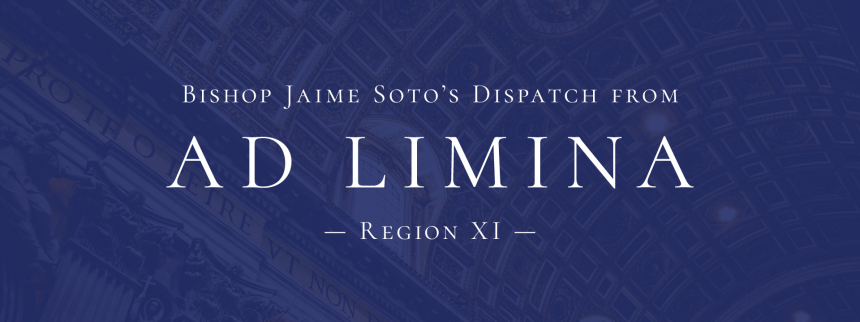
Bishop Jaime Soto shares the following reflections from the first day, Jan. 27, of the “ad limina” visit in Rome.
Bishop Emeritus William K. Weigand and I have joined our brother bishops from California, Hawaii and Nevada for the required pilgrimage to Rome. The pilgrimage is officially called the “ad limina apostolorum” (approaching the threshold of the apostles). The highlights of the pilgrimage include offering Mass together at the four major basilicas in Rome and an audience with the apostolic successor of St. Peter, Pope Francis.
It also includes a variety of meetings with various offices of the Roman Curia. In preparation for the visit, each diocesan bishop must prepare a lengthy report on the diocese under his care. I am grateful for my co-workers who assisted me in getting the document ready and submitted, as required, six months ahead of the visit. The discussions with the various curial offices and the Holy Father are based on the material received from the reports.
Rome in January does not invite many travelers. The weather has been similar to what we have been experiencing in Sacramento: gray dreary skies with showers most days. Coats and caps ward off the chill in the morning and evening.
On the first day of the “ad limina” visit, a cassock took the place of a coat as my brother bishops and I came to the Basilica of St. Peter to offer a concelebrated Mass at the tomb of this good friend and disciple of the Lord, the Rock of the Apostolic tradition. We entered this holy, historic place while the last shadows of the night were giving way to the glow of the rising sun. The interior of the basilica was hushed, with only the soft shuffle of vestments as priests and altar servers rushing to different altars arrayed around the vast ancient church to offer Mass. We vested together in the sacristy, the size of which could accommodate some of the smaller mountain churches in the Sacramento Diocese.
After a few brief instructions, we processed out of the sacristy into the voluminous nave of St. Peter’s. We turned the corner of one of the four massive baroque pillars holding up the dome of the basilica, and then descended a narrow winding staircase down to the chapel in front of the tomb of the Galilean fisherman, Simon Peter.
The sacramental nature of the Eucharist brought my brother bishops and me into that same moment when Simon Peter and the other apostles shared the Last Supper with Jesus. The Church’s sacramental mercy and God’s mercy makes this communal moment real. To be offering the Mass at the tomb of one those who was present for that great act of divine charity offered on the night before Christ died on the cross filled me with trembling. How personal was that moment when the divine in a human way offered both His body and blood for Simon Peter, for the other apostles, and now for my brother bishops and me. ”Take this and eat.” “Take this and drink.” The Lord Jesus’ personal charity with each one of us binds us to him as well as to one another. It binds us to Simon Peter and his successor.
Archbishop Jose H. Gomez of Los Angeles preached about how important this personal relationship was for Simon Peter. The personal relationship with Jesus is the soul of the apostolic tradition. The flaws and foibles of the first pope are well documented in the Gospel narratives. What saved him and continues to save the Church was the personal nature of their relationship. Peter knew the Lord. His personal testimony of the Lord’s life, death and resurrection became the rock upon which the Apostolic Tradition of the Church began. Even the great apostle Paul had to meet with Simon Peter in order to have his own testimony affirmed and credited by the testimony of Peter (Gal 1:18).
Beginning the “ad limina” pilgrimage at the Tomb of St. Peter is a sobering reminder of the wellspring and consolation of the bishop’s ministry. The Apostolic nature of the bishop’s ministry is rooted in personally knowing the Lord Jesus and, just as St. Paul did with St. Peter, sharing that testimony with the apostolic successor of St. Peter, Pope Francis.
After Mass I lingered a few moments at the tomb of Peter. The conversation of Jesus and Simon Peter echoed in my mind: “Simon, son of John, do you love me more than these?” He said to him, “Yes, Lord, you know that I love you.” He said to him, “Feed my lambs.” (Jn 21:15).
Read all Ad Limina reflections
- "The personal relationship with Jesus is the soul of the apostolic tradition"
- 'We are also bound closely to Christ who has called us to love Him and feed His flock'
- 'It is an avenue to walking more closely in the light of Christ'
- 'The radical witness of martyrdom prompts all disciples to be witnesses of Christ Jesus'

